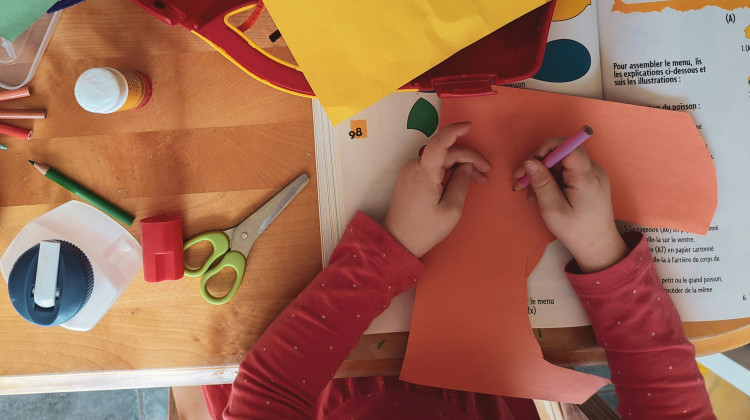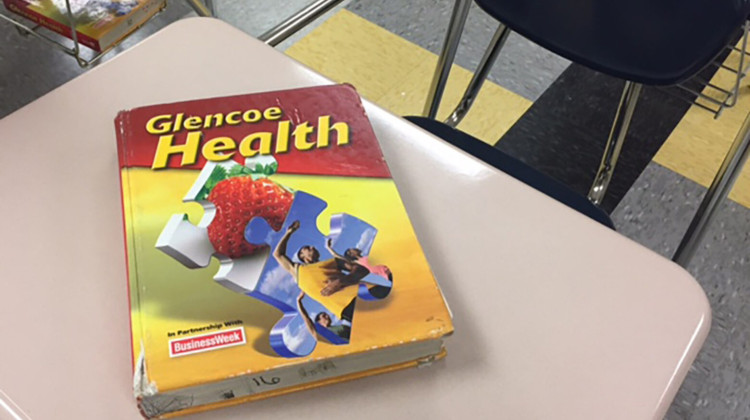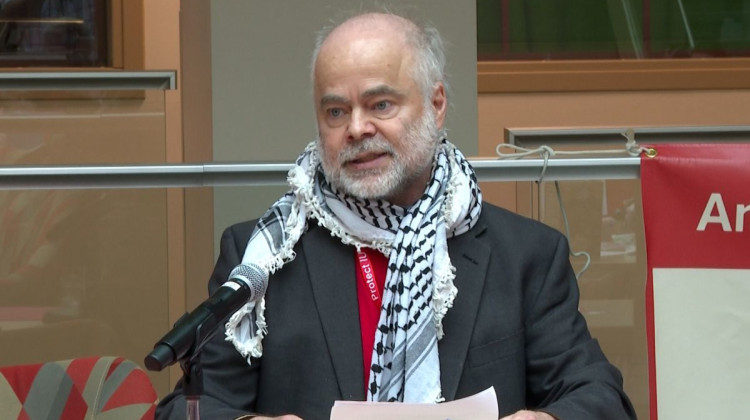
Kay Orzechowicz poses Wednesday, Sept. 2, 2020, for a portrait at her Griffith, Ind., home. After 35 years of teaching, Orzechowicz said COVID-19 "pushed her over the edge" to retire from northwest Indiana's Griffith High School at the end of July. Turning 58 in October, Orzechowicz had hoped to keep teaching for a few more years before retiring from the classroom. But after the pandemic intensified in March, the English teacher said her concerns about holding out mounted.
AP Photo/Charles Rex ArbogastINDIANAPOLIS (AP) — With many teachers opting out of returning to the classroom because of the coronavirus, schools around the U.S. are scrambling to find replacements and in some places lowering certification requirements to help get substitutes in the door.
Several states have seen surges in educators filing for retirement or taking leaves of absence. The departures are straining staff in places that were dealing with shortages of teachers and substitutes even before the pandemic created an education crisis.
Among those leaving is Kay Orzechowicz, an English teacher at northwest Indiana’s Griffith High School, who at 57 had hoped to teach for a few more years. But she felt her school's leadership was not fully committed to ensuring proper social distancing and worried that not enough safety equipment would be provided for students and teachers.
Add the technology requirements and the pressure to record classes on video, and Orzechowicz said it “just wasn’t what I signed up for when I became a teacher.”
“Overall, there was just this utter disrespect for teachers and their lives,” she said. “We’re expected to be going back with so little." When school leaders said teachers would be "going back in-person, full throttle, that’s when I said, ‘I’m not doing it. No.’”
Teachers in at least three states have died after bouts with the coronavirus since the start of the new school year. It’s unclear how many teachers in the U.S. have become ill with COVID-19, but Mississippi alone reported 604 cases among teachers and staff.
In cases where teachers are exposed to the virus, they could face pressure to return to the classroom. The Trump administration has declared teachers to be “critical infrastructure workers” in guidance that could give the green light to exempting them from quarantine requirements.
Throughout Indiana, more than 600 teacher retirements have been submitted since July, according to state data. Although the state gets most of its teacher retirements during the summer, surveys suggest more retirements than usual could happen as the calendar year progresses, said Trish Whitcomb, executive director of the Indiana Retired Teachers Association.
“I’ve gotten more (teachers) calling me back saying, ‘Well, I’m going to go ahead and retire,’” Whitcomb said. “Some still wanted to go back in the classroom, but they didn’t think the risk was worth it. They looked at their grandkids and the life they have, and I think they’re saying, ‘I’m just not going to do it.’”
In Salt Lake County, Utah, the state's most populated metropolitan area, more than 80 teachers have either resigned or retired early because of concerns about COVID-19 in schools. More than half of those happened in one of the county's five school districts, Granite School District. All of the district's teachers who left were fined $1,000 for failing to give 30 days' notice.
Mike McDonough, president of the Granite Education Association teachers union, said the departures stem from frustration over how the schools have reopened. In Granite, most students will return to in-person instruction for four days a week, and there are few opportunities for teachers to instruct solely online.
Some teachers waited until the last minute, hoping that the district would change its reopening plan. But checking out of the classroom was “the only way to keep themselves safe," he said.
“Teachers are still scared and overwhelmed," McDonough said. "I have heard from teachers that are just heartbroken to leave the classroom, but they didn’t feel safe going back. They don’t want that level of risk, and they have no other choice but to get out.”
Education leaders in states including Arizona, Kansas, New Hampshire, Pennsylvania and Texas have said they are bracing for worsening teacher shortages as the pandemic drives away some educators.
To try to maintain staffing levels in classrooms, the Missouri Board of Education made it easier to become a substitute teacher under an emergency rule. Instead of the previous requirement — 60 hours of college credit — eligible substitutes now only need to obtain a high school diploma, complete a 20-hour online training course and pass a background check.
Iowa responded similarly, relaxing coursework requirements and the minimum working age for newly hired substitutes.
In Connecticut, college students have been asked to step in as substitutes. Michele Femc-Bagwell, director of the teacher education program at the University of Connecticut, said the school has been getting requests to use fifth-year graduate students as substitute teachers. Heavy class loads and internship responsibilities, though, limit their availability to one day a week.
Many who work as substitutes are retired teachers such as 67-year-old Margaret Henderson, of Phoenix, who said she will not return as she had planned.
“I don’t want to get called into a classroom where a teacher has called out because of the virus or to quarantine. ... And we know that’s going to happen more and more,” Henderson said. “There are still uncertainties about the safety of reopening the school buildings. Can you blame (substitutes) for not wanting to go in?”
In rural Iowa’s Hinton Community Schools, Hinton High School Principal Phil Goetstouwers said the school is already down to a third of the substitute teachers it had last year. More than half of those are also willing to sub in other districts, he said, making it even more troublesome when teachers are absent.
Allen Little, who retired as a math teacher in Sioux City, Iowa, this past spring, said the “complexities” of teaching during the pandemic made him decide to retire three years earlier than he had planned. Although he anticipated returning to work as a part-time substitute this fall, fears about the virus are holding him back. He encouraged his son, who is studying to be a social studies teacher and who considered getting experience as a substitute, to weigh the risks carefully.
“We’re thinking about students, our schools, our community with every decision we make,” Little said. “But we also have to think about ourselves and our families. What’s best for us, maybe more and more of us ... is not being inside the classrooms right now.”
Associated Press Writer Pat Eaton-Robb contributed to this report from Hartford, Connecticut.
Casey Smith is a corps member for the Associated Press/Report for America Statehouse News Initiative. Report for America is a nonprofit national service program that places journalists in local newsrooms to report on undercovered issues.
 DONATE
DONATE





 View More Articles
View More Articles



 Support WFYI. We can't do it without you.
Support WFYI. We can't do it without you.